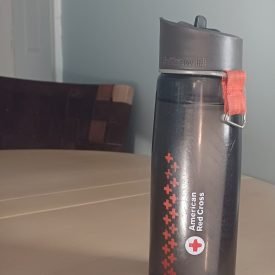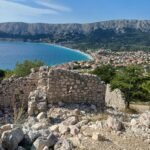Anegada: Off the BeatenTrack
Sustainable Travel Tips & Highlights
While most of the British Virgin Islands boast lush, hilly landscapes, Anegada stands apart with its flat terrain enveloped by the vast expanse of Horseshoe Reef, the third-largest reef globally. This unique geography lends Anegada a wild allure. While a vibrant party scene can be found at bars or within the anchorage, numerous tranquil spots offer solace amidst nature’s embrace.
Being a shallow island surrounded by a large coral reef makes it more difficult for larger charter boats to anchor anywhere, thus mitigating potential negative impacts on the marine ecosystem — an issue prevalent in the other islands. This inaccessibility helps to preserve some of Anegada’s marine environment, allowing the reef and seagrass beds to flourish and support marine life.
Having visited Anegada numerous times, I’m excited to share some nature-based activities ,accommodation sustainability highlights and my top sustainable travel tips to enhance your experience.

Nature-Based Activities
Snorkel Loblolly Bay: There is parking at Big Bamboo. I recommend snorkeling at lunchtime, as most people will be at the restaurant and you’re more likely to find a palapa to sit under. Have lunch afterward when the restaurant quiets down. Be mindful of the rip current, as it can be a bit intense in some areas. If you get caught in a current, swim across it. A tip is also to swim into a current at the start of your session when you are not yet tired, and down it at the end of your session.
Enjoy the unique experience of a Mangrove SUP tour with Tommy Gaunt for $60 per person for a 1.5-hour tour. You are bound to see some cool marine life such as turtles or sharks.
Take a Kiteboard Lesson at Anegada Beach Club with Tommy Gaunt. www.tommygauntkitesurfing.com. The conditions are world class with very little crowds.
Walk the numerous beaches and keep an eye on the water for marine life. There are many sharks, stingrays, larger fish, and turtles cruising around the shores.
Check out the Flamingo Sanctuary Lookout near the roundabout. The great flamingos were almost extinct but were reintroduced, and the population is coming back.
Explore the Iguana Sanctuary. The Anegada iguanas are unique to the island and also faced extinction, but they are making a comeback due to conservation efforts at the sanctuary.

Anegada Sustainable Travel Tips
Opt for reef-safe sunscreen, preferably in eco-friendly packaging.
Newcomers are often identified by the number of sandfly bite marks on their bodies, as it takes a few months for the body to develop immunity and react less to the bites. To prevent sandfly bites, consider wearing long sleeves and pants, or lather yourself with baby oil (sandflies struggle to penetrate through the oil film). Sandflies are most active at dusk and on windless days.
Bottled water is expensive, and there is limited recycling on the island, with only glass being recycled. Bring a water bottle with a built-in filtration system. Personally, I recommend using LifeStraw.
If you plan to have dinner on island, pre-order by 4 pm. Due to the islands’ remoteness, small population and food being a precious resource, restaurants aim to minimize food waste, especially meat and locally caught fish by asking customers to pre-order.
The sun can be intense on this flat island with little shade and a lot of sunlight reflecting on the water. Protect yourself from the harsh sunrays by packing lightweight long-sleeve shirts and pants, a hat, sunglasses, and reef-safe sunscreen.
When snorkeling, avoid touching the reef, as coral reefs are delicate ecosystems that can be damaged or even killed by contact.
Bring your own snorkel mask. To prevent fogging, spit in your mask before snorkeling, rub it in, wait 10 minutes, then rinse before putting the mask on. Spit is just as effective as anti-fog spray found in dive shops, without the cost or waste.
When swimming or snorkeling, be aware of rip currents. If caught in a current, swim across it and towards the shore.
Do not touch or disturb wildlife. During turtle nesting season (March-May), if you encounter a turtle nest or tracks, leave them undisturbed. If possible, notify the local non-profit group, Association of Reef Keepers (www.bviark.org).
When entering the water, always shuffle your feet to avoid stepping on stingrays, which can result in a hospital visit and hours of severe pain if stung. If stung, soak the affected area in hot water for at least an hour.
Support local conservation groups like Beyond the Reef (known for creating the life-sized humpback whale structure at the roundabout, www.1beyondthereef.com). They focus on tackling “Ghost Fishing,” coral restoration/SCTLD, coastal cleanups and shark research. BVI Ark (Association of Reef Keepers, www.bviark.org) also contributes significantly to local turtle conservation efforts.
Water is a precious resource on this dry island. Conserve water where possible, such as by avoiding long showers or turning off the water when lathering up, if staying on island.
If you’re on a charter boat, use a mooring in the anchorage and avoid anchoring, especially on seagrass beds or coral. Additionally, refrain from flushing harmful chemicals like chlorine or Fabuloso down boat toilets, as these can negatively impact the marine environment. This tip hits home as I have personally seen the degradation of the marine environment, and more and more tourists complaining about not seeing as much marine life as they used to “back in the day” . Every boats’ and tourists’ actions have an impact on such a small, fragile ecosystem. Please do your part by avoiding touching the reef or anchoring on seabeds, which serve as feeding grounds for marine life such as turtles and stingrays.
Leave sea shells on the beach. Similar to the previous tip, I have had tourists complain to me about how a beach does not have many shells. If thousands of tourists visit a beach each year, then that’s thousands of fewer shells on the beach. Each small impact adds up due to the volume of tourists. It is illegal to remove shells from the BVI. Respect and enjoy the beauty of the environment where it is.
The only material that can be recycled on island is glass. So if on a charter boat, hold onto your recyclables until returning to Tortola or Virgin Gorda and avoid single-use plastic.

Accommodation Sustainability Highlights
When I visit Anegada, my go-to spot is Anegada Beach Club. Not only is their customer service top-notch and their amenities superb, but they also prioritize sustainability initiatives. The following initiatives not only contribute to sustainability but also enhance the overall experience. I hope these ideas can inspire other hotels to follow suit and implement sustainability initiatives that work for them.
Refillable hand soap and lotion are provided above the bathroom sink.
Refillable shampoo, conditioner, and body wash are available in the shower.
Educational materials are provided for guests, offering tips on water and energy conservation. For example, guests are encouraged to turn off the air conditioning and lights when not in the room, and information on a towel reuse program is readily available.
Reusable plastic cups are provided for guests heading to the beach or pool area. If eating or drinking at the restaurant, guests are provided meals and drinks in reusable dishware.
The reception area features a small store that sells eco-friendly products, such as reef-safe sunscreen lotion.
Drought-resistant landscaping is utilized to minimize the need for watering.
Dinners are recommended to be pre-ordered with the aim of reducing food waste.


Having visited Anegada numerous times, I’m thrilled to share with you some nature-based activities, accommodation sustainability highlights, and my top sustainable travel tips to elevate your experience. I hope that these tips can help make your trip to Anegada more sustainable and enjoyable!
Happy Exploring!









